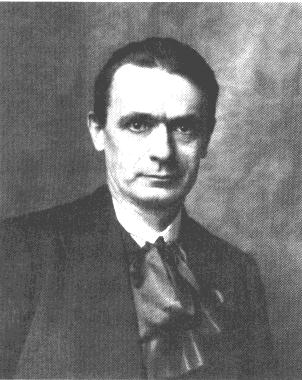Anthroposophy: Rudolf Steiner's 'Spiritual Science'
by Rob Boston
© Church
& State, April 1996, reproduced by
permission
Americans
United for Separation of Church and State
return to
PLANS page
Promoters of Waldorf education insist that the movement's schools are
non-sectarian. Critics disagree, asserting that the institutions are
based on an occultic religion known as "Anthroposophy."
What is Anthroposophy? Answering that question
requires a look at the views of the man who founded the
Anthroposophical Society--Rudolf Steiner.

Rudolf Steiner
Steiner's movement grew out of the spiritualist craze
that swept Europe and the United States in the late 19th century.
Steiner, an Austrian scholar who had edited the works of German
dramatist/poet Johann Wolfgang Goethe, developed an interest in
mystic philosophy that over the years acquired a Christian
veneer.
Steiner, who lived from 1861 until 1925, believed in the existence of
a spiritual world that is accessible to pure thought only through the
highest faculties of mental knowledge. Long ago, he held, humans
possessed the ability to fully take part in the spirit world, but
they had lost the ability due to an undue attachment to the material
world. Anthroposophy, which Steiner called a "spiritual science," was
designed to train people to rise above the material and once again
focus on the spiritual world.
According to Steiner, people existed on Earth since the creation of
the planet. Humans, he taught, began as spirit forms and progressed
through various stages to reach today's form. Humanity, Steiner said,
is currently living in the Post-Atlantis Period, which began with the
gradual sinking of Atlantis in 7227 B.C. (According to legend,
Atlantis was an island-continent that sank into the Atlantic Ocean
many ages ago.) The Post-Atlantis Period is divided into seven
epochs, the current one being the European-American Epoch, which will
last until the year 3573. After that, humans will regain the
clairvoyant powers they allegedly possessed prior to the time of the
ancient Greeks.
In 1902, Steiner was elected to the leadership of the German
Theosophical Society, a movement founded in 1873 by spiritualist
leader Helena Petrovna Blavatsky. Blavatsky believed that humankind
was moving through a series of stages that would result in the
creation of purely spiritual beings. The key to advancement, she
believed, was found in the "ancient wisdom" of early cultures such as
the Egyptians and Greeks. Such wisdom was often said to be "occult"
or hidden.
But Steiner's views failed to mesh fully with the Theosophists. He
believed, for example, that ancient mystics had paved the way for
Christ's appearance on Earth and taught that Christianity had
supplanted Eastern religions. By contrast, Theosophists believed that
Christ was simply another teacher in a long line of mystics and that
Christianity was no better than other religions.
The rift between Steiner and the Theosophists grew as he began
publishing his ideas. In 1912 he formally split from the Theosophical
Society and formed the Anthroposophical (literally "knowledge about
man") Society, headquartered in Dornach, Switzerland. In 1919 Steiner
was invited to give a series of lectures to workers at the
Waldorf-Astoria cigarette factory in Stuttgart, Germany. After the
lectures, the factory's owner asked him to open a school for the
children of the workers, hence the name "Waldorf school." The first
U.S. Waldorf school opened in New York City in 1928.
In 1922 Steiner and his followers formed an allied religious body
called the Christian Community, which offered a liturgy and rituals
for Anthroposophists. By 1925 Anthroposophy had spread throughout
Europe and had established a toehold in the United States. Never a
large movement in America, Anthroposophy had no permanent U.S.
presence until the establishment of the first Christian Community in
1948. Although the Anthroposophical Society and the Christian
Community are now formally separate, religion scholar J. Gordon
Melton notes in The Encyclopedia of American Religions that the two
groups retain close ties and that both "function as a religious
body...."
Today there are 100 Waldorf schools in the United States and Canada
with another 115 in the process of officially becoming Waldorf
institutions. The schools are also common in other countries, where
they are called "Steiner schools." More than 600 Waldorf schools
operate in 32 countries, serving approximately 120,000 students.
Waldorf schools reflect Steiner's education theories, which hold that
children advance through three stages. Anthroposophists believe that
during the first stage, birth to age 7, the spirit inhabiting the
body of the child is still adjusting to its surroundings, hence lower
grades in Waldorf school offer minimal academic content. Reading is
not introduced until second or third grade. During the second stage,
ages seven to 14, children are said to be driven primarily by
imagination and fantasy, so students are introduced to mythology.
After age 14, the third stage, an astral body is believed to be drawn
into the physical body, creating the onset of puberty.
Waldorf schools place a heavy emphasis on the arts. All students are
taught to knit and play the recorder. Four "seasonal festivals" are
celebrated in school &emdash; Michaelmas, Christmas, Easter and St.
John's Day &emdash; with the aim, as Waldorf literature states, to
"connect humanity to the rhythms of nature and of the cosmos."
The drive to make some Waldorf schools "public" through charter
programs is ironic, considering Steiner's views on government
assistance. Asked about the issue once, Steiner replied, "It seems
dubious to me that it should be possible to run a school with the aid
of state subsidies. For I very much doubt whether the government, if
it pays out money for such a school, would not insist on the right to
inspect it. Therefore, I cannot believe that a free school could be
founded with state subsidies, which in themselves imply supervision
by inspectors from the education authorities."
If you would like to subscribe to Church & State Magazine or
would like to receive additional information, please click here for
General
Information & Membership
return to PLANS
page

